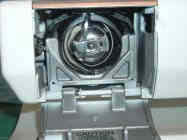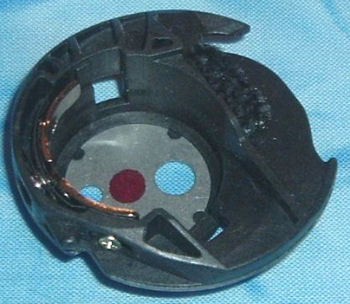
Understanding Sewing Machine Hook Systems.There are to basic types of sewing machine hook assemblies. There is the Rotary Hook assembly. And there is the Oscillating Hook assembly. Each type has its own features and benefits. They both do essentially the same job. It is important to understand sewing machine hook systems.
The Rotary Sewing Machine Hook Assembly is a hook that moves in a complete circle. It rotates round and round. The sewing machine hook slides behind the needle. It proceeds all the way around the bobbin carrier. It slides behind the bobbin carrier. Singer sewing machines revolutionized the sewing world. They introduced their drop in rotary sewing machine hook systems. Maintaining the sewing machine hook is a vital sewing machine repair.
Is the bobbin a top loading bobbin. Is it placed just below the needle plate and a slight bit in front of it? If so, it is a rotary sewing machine hook. The bobbin may be inserted in the left end of the sewing machine arm. Or it may be inserted on the front face of the sewing machine arm. A bobbin inserted on the left or front may be a rotary sewing machine hook. Or it may be an oscillating sewing machine hook.
A rotary sewing machine hook moves around in a continuous circular motion. An oscillating sewing machine hook moves back and forth. How can you tell which type of sewing machine hook assembly you have? Watch the place where you insert your bobbin. Turn the hand wheel toward you. Watch the sewing machine hook. The sewing machine hook is a metal piece just outside or behind of your bobbin carrier. Watch it as it turns. Does it go all the way around? If so it is a rotary sewing machine hook. Does it go part way and retrace its path to start over? If so it is an oscillating sewing machine hook? Knowledge of the sewing machine hook is essential for sewing machine repair. The Oscillating Sewing Machine Hook Assembly has a sewing machine hook with a starting position. It begins a few millimeters to the top left of the needle. It moves to the right sliding behind the needle. It goes past the needle and moves around to the bottom of the swing. The oscillating sewing machine hook travels back again. It moves the same way to its original position for a return oscillation. Bernina sewing machines built a superior reputation. It was based on their advanced oscillating hook system called a CB Hook. Both systems do essentially the same thing. The point of the sewing machine hook passes behind the needle. It is positioned slightly higher than the eye of the needle. The upward travel of the needle causes a small loop of thread to form on the back side of the needle. This loop is just above the eye. It is amplified by a space called the scarf. This is cut out of the back of the needle above the eye. The point of the hook snags the thread. It moves behind the needle. It pulls the thread around the bobbin thread. As the needle rises, the threads are tightened into a lockstitch. Any variation will require sewing machine repair. The movement and positioning of the sewing machine hook and needle must coordinate exactly. Slight variations result in skipped stitches. It can cause poorly formed stitches. There may be no stitches at all. As the hook
and needle travel, they move through a finite pattern. For each
stitch the hook and needle must align perfectly. As the needle
rises, the loop must form on the back of the needle. The point
of the hook must travel to There are several ways to adjust the hook needle timing. It depends on the sewing machine model. Some adjust the position of two interlocking gears immediately below the sewing machine hook. Some must be adjusted at the right side of the lower shaft. This is where the lower shaft joins the vertical shaft. Some must be adjusted by adjusting a timing belt. In all cases, the needle and hook must meet at the right time in the right way to form stitches. This is essential for proper sewing machine repair. Understanding Sewing Machine Hook Systems. |
(C) 2010 All Rights Reserved Dr. David Trumble Author Fix Sewing Machines. Com.
502 San Gabriel Blvd. Georgetown, Tx 78628 (512) 635-5705



